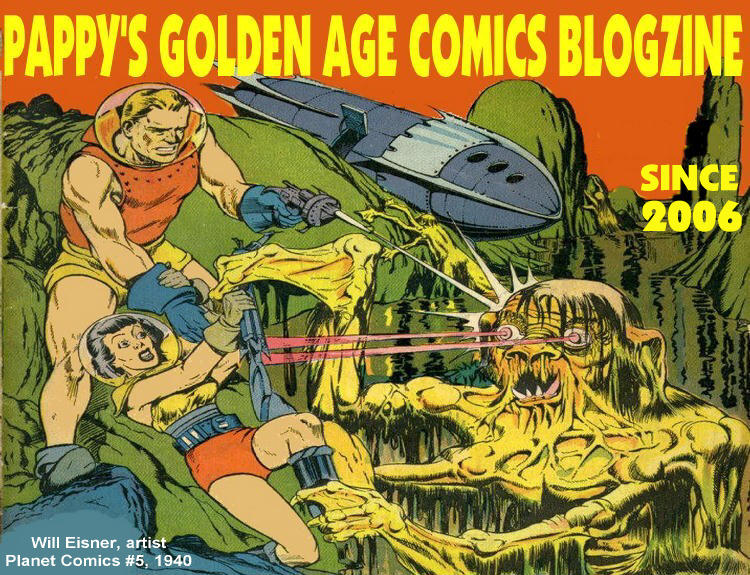The Hangman (Bob Dickering) had an interesting gimmick. When he cornered the guy he was after the shadow of the gallows fell on the felon's face. I wondered how he did that...then I watched one of those “reality” shows where we’re not supposed to think about a platoon of cameramen, lighting techs, sound guys, etc., following these “real” people around in their “real” daily endeavors. Maybe Hangman had a lighting guy who stood over his shoulder, and when the time was right would hold up a tiny gallows in front of a powerful light. Okay...so it’s a comic book and they don't have cameramen. I just needed to get that out, because Hangman's gimmick always bugged me, and if they explained it in any of the Hangman stories I've missed it (or forgotten).
This story, which comes from Pep Comics #34 (1942) is a good example of the series. Bob Fujitani, working in his early style with overtones of Will Eisner’s influence, drew some very dynamic and dramatic pages. There's even a scene of a guy getting shot through the head, which wasn't exactly typical of these stories, but gory stuff did happen. M.L.J. Magazines, Inc., publishers, was into the action, violence and horror that appalled parents and grownups across America. They also sold to servicemen who were more likely to handle this sort of thing, but it was the kids everybody worried about. After a time the line began concentrating on their teenage comics and out of bloody M.L.J. cleancut Archie Comics was born. Well, cleancut compared to this episode of Hangman. I remember some sexy stuff going on in Archie, but no one got a bullet through the brain.
I'm including a page on editor Harry Shorten. Shorten did comics, paperback book publishing, a comic strip (“There Oughta Be A Law” with Al Fagaly) and then comics again in the sixties with T.H.U.N.D.E.R. Agents. All of that was ahead of Shorten when this biography was written, but you can see from it that Shorten took to the industry early on.
















5 comments:
Okay, I'll offer you two theories.
The first is that, in exchange for letting Fujitani follow him around (in order to draw things as they had happened), the Hangman had Fujitani deal with projecting the shadow.
The second is that the shadow is a deviation from representational realism into more overt symbolism, and not to be taken as having literally been cast.
Daniel, the first explanation must be it, because panel two of page four states the casting of the shadow of the gallows as literal, not symbolic as per your second explanation.
Of course, we are talking about a comic book, here...always good to keep that in mind, and I must remember to jerk myself back into reality when my mind dwells on such things.
Fujitani has a very dynamic graphic style, though is draftsmanship is lacking. I also love the gimmick of the the hangman noose on the face. Obviously this is a take on the pentagram on the Wolfman's future victim's hand.
The tale is let down by obvious nonsensical wartime propaganda. Of course the Nazis relied on coal derived synthetic gas and were badly strapped for energy, while America (at the time) had almost unlimited resources thanks to the Texas oil fields which the axis couldn't hope to touch. And then there's the problem of labeling oil fields in Mexico as "American" -- which they are not, and is really politically incorrect in this day and age -- but what the hell, it's 1942 here...
Thanks for posting.
Hangman's brother The Comet had a brief, violent, and incompetent career that I've always found fascinating; gaining superpowers by injecting an unknown gas into his blood just to see what would happen, John Dickering became a flying proto-Cyclops with eyes that fired disintegration beams which he didn't hesitate to use on the bad guys.
By his third appearance, a supervillain had coerced The Comet through hypnosis into killing a load of cops, and as he snapped out of it Comet promptly disintegrated the only person who could clear his name.
On the run (because he had told the FBI his secret identity) Comet continued to fight crime, but crime fought back and John Dickering eventually got shot up by thugs and died on a sofa.
In one of those things that only happens in the funnies, John bequeathed his girlfriend to his brother with his dying breath, and Bob Dickering decided it would also behoove him to become a costumed superhero (albeit one without powers).
The Comet died in his seventeenth outing, the first superhero to get killed. (Two years later, mystery-man "711" would be unceremoniously cracked off over in Quality Comics, in a story narrated by his murderer.) The Hangman lasted about thirty months, briefly had his own book, and apparently retired in one piece with his brother's girl.
Billy, thanks for the history. I think you've encapsulated the Dickering Brothers Comet/Hangman history better than any of the superhero bios of the pair I've read. Very entertaining. Thanks for taking the time to write.
Trevor, you bring up a good point, which is the resources Americans had during the war. There was talk among scientists of the era that the United States would be the one to build a nuclear bomb, for instance, because of the unlimited resources we had within our borders. It might have been a reason that much fiction about the war coming to America was more about sabotage and saboteurs than bombings. We knew at the time no country had the ability to fly to our country and bomb it from the air, nor was it likely they would try to invade from the sea. But they could try to destroy our war production plants, oil supplies and power grids across the country...which, to be honest, an enemy could still do.
Post a Comment